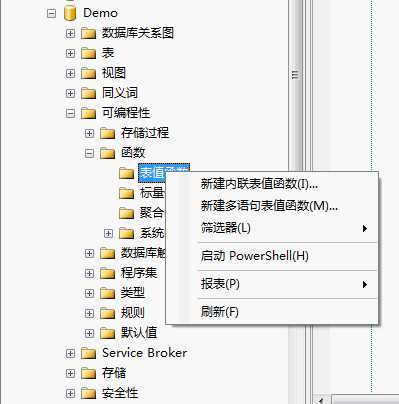标签:des blog http 使用 os io strong 数据
关于SQL Server用户自定义的函数,有标量函数、表值函数(内联表值函数、多语句表值函数)两种。
题外话,可能有部分朋友不知道SQL Serve用户自定义的函数应该是写在哪里,这里简单提示一下,在Microsoft SQL Server Managerment Studio里面,展开具体需要创建SQL Server用户自定义函数的数据库(即每个用户自定义函数只针对具体的一个数据库有用),然后找到可编程性选项,再展开找到函数选项,在具体的函数选项里面可参照下图的方式鼠标右键选择来添加。

| 标量函数 |
所谓标量函数简单点来讲就是返回的结果只是一个标量,对于我来讲,返回的结果就是一种类型的一个值。
写法如下:
-- =============================================
-- Author: <Author,,Name>
-- Create date: <Create Date, ,>
-- Description: <Description, ,>
-- =============================================
CREATE FUNCTION <Scalar_Function_Name, sysname, FunctionName>
(
-- Add the parameters for the function here
<@Param1, sysname, @p1> <Data_Type_For_Param1, , int>
)
RETURNS <Function_Data_Type, ,int>
AS
BEGIN
-- Declare the return variable here
DECLARE <@ResultVar, sysname, @Result> <Function_Data_Type, ,int>
-- Add the T-SQL statements to compute the return value here
SELECT <@ResultVar, sysname, @Result> = <@Param1, sysname, @p1>
-- Return the result of the function
RETURN <@ResultVar, sysname, @Result>
END
例子:
-- ============================================= -- Author: <Author,,Name> -- Create date: <Create Date, ,> -- Description: <Description, ,> -- ============================================= CREATE FUNCTION GetSum
( @firstNum int, @secondNum int ) RETURNS int AS BEGIN -- Declare the return variable here DECLARE @result int -- Add the T-SQL statements to compute the return value here SELECT @result=@firstNum+@secondNum -- Return the result of the function RETURN @result END GO
题外话:我们来看看上面的写法,对于SQL Server来讲,我们声明一个变量的方式是用@变量名,而且相对于编程来讲,SQL Server声明的方式跟我们开了个玩笑,是先变量后面才是类型。对于需要传参跟不需要传参的方式,其实跟我们编程的方式一样。有参数则是如下方式:
CREATE FUNCTION GetSum
(
@firstNum int,
@secondNum int
)
如果没有参数,则只要保留括号即可。跟我们理解的函数写法一致。
CREATE FUNCTION GetSum ( )
对于返回方式,这跟我们编程的方式又不大一样。SQL Server函数的返回类型并不放在函数名前面,而是函数名括号的后面。而且函数的返回类型需要用到返回关键字RETURNS,而不是RETURN。
对于函数来讲,当然也会有所谓的函数体。标量函数也一样。它的函数体是包含在:
AS
BEGIN
-- 函数体
END
对于需要在函数体里面声明变量的话,则需要使用到DECLARE关键字进行声明。函数体内的返回才是关键字RETURN。
好了,标量函数的例子也举完了,要存到数据库里面,还需要点击Microsoft SQL Server Management Studio工具里的执行操作。这样之后,就可以在查询窗口里面跟查询表数据一样来查询结果了。
使用方式好懂吧,但是需要注意的是[dbo]这个对象名在不能省,[GetSum]函数后面可也别少了()。说来也奇怪,对于表值函数来说,对象名[dbo]倒是不写也可以正确执行。
select [dbo].[GetSum]()
| 内联表值函数 |
相对于标量函数只返回一个标量值,内联表值函数返回的是表数据。当然罗,表数据就是Table类型。
写法如下:
-- =============================================
-- Author: <Author,,Name>
-- Create date: <Create Date,,>
-- Description: <Description,,>
-- =============================================
CREATE FUNCTION <Inline_Function_Name, sysname, FunctionName>
(
-- Add the parameters for the function here
<@param1, sysname, @p1> <Data_Type_For_Param1, , int>,
<@param2, sysname, @p2> <Data_Type_For_Param2, , char>
)
RETURNS TABLE
AS
RETURN
(
-- Add the SELECT statement with parameter references here
SELECT 0
)
GO
例子:
-- =============================================
-- Author: <Author,,Name>
-- Create date: <Create Date,,>
-- Description: <Description,,>
-- =============================================
CREATE FUNCTION [GetMoreThanSalary]
(
@salary int
)
RETURNS TABLE
AS
RETURN
(
SELECT [FName],[FCity],[FAge],[FSalary] FROM [Demo].[dbo].[T_Person] Where [FSalary] > @salary
)
GO
题外话:标量函数上面提过的内容,这里就不重复了。内联表函数返回的表结构由函数体内的SELECT语句来决定。
对于标量函数来讲,函数体是包含在如下结构中。
AS
BEGIN
-- 函数体
END
但是对于内联表值函数来讲,函数体的结构则是如下的方式。内联表值函数只执行一条SQL语句后返回Table结果。
AS
RETURN
-- 函数体
END
执行表值函数的方式如下:
select [FName],[FCity],[FAge],[FSalary] from [dbo].[GetMoreThanSalary](8000)
可以看得出,这种执行方式就跟普通表的执行方式一样了。表值函数其实相当于存储在内存空间里面的一张虚拟表。
| 多语句表值函数 |
多语句表值函数跟内联表值函数都是表值函数,它们返回的结果都是Table类型。多语句表值函数顾名思义,就是可以通过多条语句来创建Table类型的数据。这里不同于内联表值函数,内联表值函数的返回结果是由函数体内的SELECT语句来决定。而多语句表值函数,则是需要指定具体的Table类型的结构。也就是说返回的Table,已经定义好要哪些字段返回。所以它能够支持多条语句的执行来创建Table数据。
写法如下:
-- =============================================
-- Author: <Author,,Name>
-- Create date: <Create Date,,>
-- Description: <Description,,>
-- =============================================
CREATE FUNCTION <Table_Function_Name, sysname, FunctionName>
(
-- Add the parameters for the function here
<@param1, sysname, @p1> <data_type_for_param1, , int>,
<@param2, sysname, @p2> <data_type_for_param2, , char>
)
RETURNS
<@Table_Variable_Name, sysname, @Table_Var> TABLE
(
-- Add the column definitions for the TABLE variable here
<Column_1, sysname, c1> <Data_Type_For_Column1, , int>,
<Column_2, sysname, c2> <Data_Type_For_Column2, , int>
)
AS
BEGIN
-- Fill the table variable with the rows for your result set
RETURN
END
GO
例子:
-- =============================================
-- Author: <Author,,Name>
-- Create date: <Create Date,,>
-- Description: <Description,,>
-- =============================================
ALTER FUNCTION DemoFun
(
)
RETURNS
@result TABLE
(
name nvarchar(20),
city nvarchar(20),
age int,
salary int
)
AS
BEGIN
-- Fill the table variable with the rows for your result set
insert into @result(name, city, age, salary)
select FName,FCity,FAge,FSalary from dbo.T_Person where FSalary>8000
insert into @result(name, city, age, salary) values
(‘测试‘,‘China‘, 1, 0)
RETURN
END
GO
题外话:可以看得出,多语句表值函数的返回结果是定义好表结构的虚拟表。这又跟标量函数一样了吧,只不过标量函数是返回一种类型的标量值而已。而且在多语句表值函数里面,你也会发现最后一句是RETURN。告诉执行程序,多语句表值函数已经执行完成。函数体结构跟标量函数的结构一样。对于类型放在变量后面这种方式确实需要好好转换一下观念。
RETURNS
<@Table_Variable_Name, sysname, @Table_Var> TABLE
(
-- Add the column definitions for the TABLE variable here
<Column_1, sysname, c1> <Data_Type_For_Column1, , int>,
<Column_2, sysname, c2> <Data_Type_For_Column2, , int>
)
内容倒是不多,但是要熟练使用的话,还是需要在项目中多加使用才行。网上有一些网友总结出来的常用自定义函数大家可以收集积累,就像做项目一样,好的方法要形成所谓的开发库,帮助我们在下一个项目中复用。节省我们的开发时间,提高我们的工作效率。
至此,本文完。
标签:des blog http 使用 os io strong 数据
原文地址:http://www.cnblogs.com/haore147/p/3902988.html